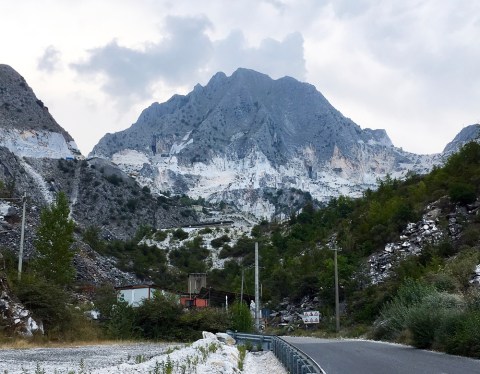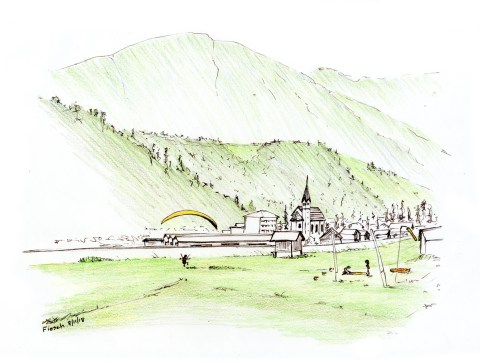John Singer Sargent’s Carrara Watercolors
One of the reasons I wanted to go to Carrara, I’m not ashamed to admit, is because James Bond had a car chase there. Switchbacks, stone, and big machines, sign me up. Another reason is Edward Burtynsky’s stunning photos. His book, Quarries, features Carrara on the cover and first convinced me that the landscape would be beautiful. But probably the biggest reason is the series of paintings by my favorite watercolorist, John Singer Sargent. I’ve never seen them in person and I’m not sure how many he actually did, but for years I’ve grabbed them off the internet whenever I’ve seen them. They might not be as important as his paintings of Venice and I’m sure I attach more importance to them than most other people, but it’s the world’s greatest watercolorist painting one of the world’s great cultural landscapes. Fantastic.
Titles and dates for most of them can be found at the John Singer Sargent Virtual Gallery, along with some pencil studies that are interesting to see. As I understand it, he visited the quarries twice, in 1911 and 1913, the era of dynamite and oxen at the quarries, before the workers had the big machines and the wire saws they use today. I love how many of the paintings show workers carrying ropes up the mountain. The weight of the stone is obvious, but I’m fascinated too by how heavy the ropes would have been and how much effort would have been put into just moving them around. Not an easy place to work.
Another dozen more are below. Read the rest of this entry »
Carrara
Originally on my trip I had planned to go to Florence, but, after realizing how crowded it would be, I headed towards the coast. Instead of waiting in a long line and shuffling past Michelangelo’s David, I decided I’d rather ride around on the mountain where they quarried the marble for it. I still want to see David, but I’ve no regrets, Carrara is awesome. It has a sculptural quality equal to any statue. I didn’t quite capture it in the photo above, but the quarries girdling the mountain are creating a two-toned effect, weathered gray rock above a shining marble pedestal. It’s not as dramatic as the Cuernos del Paine, where glaciers created the two-toned effect instead of humans, but it’s the closest I’ve ever seen and an amazing by-product of the quarries.
That’s a beautiful cliff face. Many quarries are ugly scars, but not Carrara. I took a tour with Cave di Marmo, and then cycled around on the roads that are open to the public. It wasn’t quite as exciting as driving an Aston Martin with thugs shooting machine guns at me, but the downhills were fun, and a long unlit tunnel was sort of scary.
There was a ridge or saddle here in the past, and the quarrying is making separate peaks.
The current process in Carrara is to start at the top and work down in benches ten meters deep. They drill three holes — one from the top and two from the sides — that meet at a single point and then they run a cable with diamond-crusted studs through the holes to make a loop. The cable spins very fast and slices the stone, first one side, then the other, and then the bottom. Then with machines they tip the block over onto a bed of rubble and break it down into smaller blocks to haul down the mountain and ship all over the world.
The piles of rubble in the photos are there for practical reasons, to cushion the landing of the blocks as they are pulled away from the cliff, rather than sloppy housekeeping. I posted a movie trailer with footage from Carrara showing the process a few years ago. Since then I’ve seen the full movie, it’s great, highly recommended.
They use water to cool the cable as it cuts, so you see large puddles of milky water everywhere they are actively cutting. They fill the water tanks from springs coming out of the mountain, delicious marble-filtered water I had a chance to taste while I was riding around. I saw a trucker pull over to fill his water bottle at a roadside spring. I asked if it was ‘Buona’ and he said ‘Buonissima!!!’ Like holy water for a mason or something, perhaps my chisel will now carve with greater acuity.
It looks like a slow unhurried process with only a few people working at a time, but then you realize the size of the stone blocks they are pulling off the mountainside.
Switzerland Drawings
These are my drawings from Switzerland. They loosely track my progress across the country. The furthest west is from Lausanne on Lake Geneva. The last is a view from Guarda, a town in the lower Engadine near the Austrian border. The interior view and the pool are from Therme Vals, Peter Zumthor’s phenomenal thermal baths.
Castro Valley Lawn Conversion
I try to do one or two posts about lawn-to-garden conversions every spring, sort of an annual contribution to the anti-lawn propaganda movement. So far this is the only one I’ve photographed this year. I don’t have a lot to say about it, just that it seems clear to me how much better the planting looks than the lawn. I guess the previous owner kept the lawn so it would be possible to drive a camper van to the backyard. You can’t drive into the backyard anymore.
During the drought the new owner let the lawn dry out, then we replaced it with this simple little planting — mostly evergreen, some purple flowers and purple foliage, a bit of eye-catching yellow when the Kniphofia blooms, low-water, relatively low-maintenance, plants that are long-lived and can survive the unskilled ministrations of the mow-and-blow gardeners. Like many lawn conversion projects, it needed a low-cost path through the planting and, in this case, a couple of steps made with granite curbstones. Pretty straightforward, and such a huge improvement. These are the kind of ‘before and after’ images that I think about when I get pushback against the idea of removing front yard lawns. I really struggle to understand why people cling to their lawns.
We sheet mulched over the dead lawn, but more to smother weeds than the grass. The grass was pretty well dead by the time I first saw it, and to me the planting brought the space back to life.
Five Seasons: The Gardens of Piet Oudolf
Five Seasons: The Gardens of Piet Oudolf documentary trailer from Thomas Piper on Vimeo.
The Piet Oudolf movie, Five Seasons, is coming to the Bay Area this week, with showings in Berkeley, San Rafael, and San Francisco. I haven’t seen it yet but I’ve been anticipating it for quite a while now. Oudolf is probably the single biggest figure in the plant world and I’m excited to see his work up on the big screen. It’s not to be missed. There are details about the showings at the movie’s website.
Nyssa sylvatica
Along with the Hawthorn, another underappreciated tree in the Bay Area is Nyssa sylvatica, Tupelo. It’s not a flashy tree for much of the year, so it’s not well known around here. It’s slow growing, but in return it is long-lived, has strong branches that rarely need pruning, and its roots rarely cause damage. It handles drought and poor drainage. The regular species (the photo below) is a little nondescript but the cultivar ‘Wildfire’ (above) has red in its new spring growth. Both species and cultivar have beautiful fall color. Supposedly they can drop dried fruit, but I’ve never seen that happen. An added bonus is that whenever I see one I hear Tupelo in my head, one of my favorite Nick Cave songs.
The three in the photo above are in their third year. The one below is about ten years old. It’s the first one I ever planted, in a garden that was at one time known as the garden of death. Twelve years ago during a major remodeling one of the workers parked his Hummer in the front yard all winter long and compacted the soil so badly it became the type of clay you’d use to make a pot rather than grow plants, the heaviest clay I’ve ever seen. Almost everything died when they first planted. When we were hired, we found standing water would form anywhere we dug a hole. But the Nyssa never seemed to mind. It has grown slowly but steadily in the spot where a plum tree had been unable to survive. It looks after itself better than almost any tree I know.



























